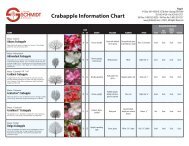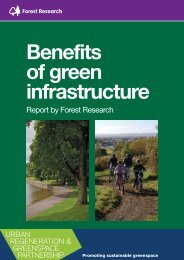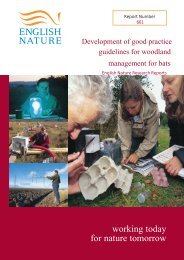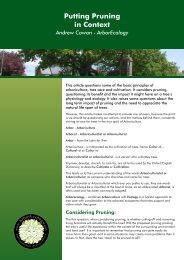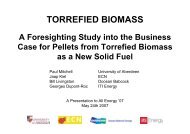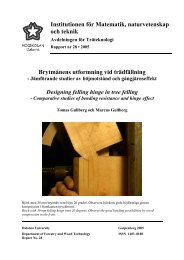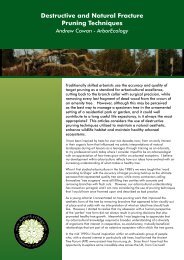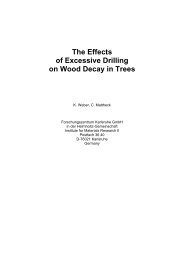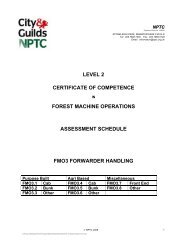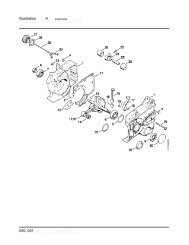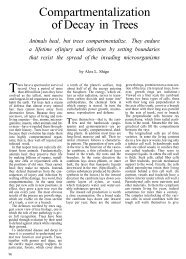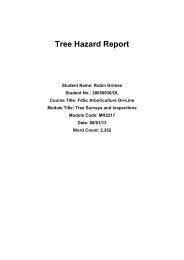Ganoderma on Trees.pdf - Arbtalk
Ganoderma on Trees.pdf - Arbtalk
Ganoderma on Trees.pdf - Arbtalk
Create successful ePaper yourself
Turn your PDF publications into a flip-book with our unique Google optimized e-Paper software.
© Copyright F.W.M.R Schwarze and D. Ferner May 2003<str<strong>on</strong>g>Ganoderma</str<strong>on</strong>g> <strong>on</strong> <strong>Trees</strong> - Differentiati<strong>on</strong> of species and studiesof invasivenessF.W.M.R. Schwarze and D. FernerProfessur für Forstbotanik, Albert-Ludwigs-Universität Freiburg, D-79098 Freiburg,GermanySummaryThe relative abilities of <str<strong>on</strong>g>Ganoderma</str<strong>on</strong>g> applanatum, G. resinaceum and G. adspersum toovercome the reacti<strong>on</strong> z<strong>on</strong>e (R-z<strong>on</strong>e) of Platanus x acerifolia were assessed underc<strong>on</strong>trolled c<strong>on</strong>diti<strong>on</strong>s using wood blocks c<strong>on</strong>taining naturally induced R-z<strong>on</strong>es. Also,the effect of physically damaging the R-z<strong>on</strong>e <strong>on</strong> fungal spread was examined. Duringincubati<strong>on</strong>, fungal entry into each block was c<strong>on</strong>trolled by coating it with paraffinwax, so as to leave <strong>on</strong>ly <strong>on</strong>e side available for col<strong>on</strong>isati<strong>on</strong>. The results wereexamined mainly in the c<strong>on</strong>text of the different col<strong>on</strong>isati<strong>on</strong> strategies and wooddegradingmechanisms of these fungi. In order to allow for possible intra-specificdifferences, two isolates of each fungus were used.There were clear differences between the fungi, <strong>on</strong> the basis of both histologicalcriteria and drilling resistance measurements, as determined after four and eightweeks’ incubati<strong>on</strong>. Both G. adspersum and G. resinaceum breached the R-z<strong>on</strong>e, butthe G. adspersum was more aggressive in this respect (Fig. 11). On the other hand, G.applanatum did not breach the R-z<strong>on</strong>e, due to an inability to modify the defensivecompounds in this regi<strong>on</strong>.When wood blocks were drilled before incubati<strong>on</strong>, so as to breach the R-z<strong>on</strong>esphysically, G. applanatum was able to col<strong>on</strong>ise and degrade the adjacent sapwood.This pre-treatment also enhanced the ability of G. resinaceum and G. adspersum toenter the sapwood. <str<strong>on</strong>g>Ganoderma</str<strong>on</strong>g> resinaceum preferentially exploited the sapwoodbefore starting to degrade the polyphenolic barrier of the R-z<strong>on</strong>e, whereas G.adspersum began to degrade this barrier at an early stage.For further informati<strong>on</strong> please c<strong>on</strong>tact Page 1 of 21ENSPEC Pty Ltd <strong>on</strong> craig.hallam@enspec.com
© Copyright F.W.M.R Schwarze and D. Ferner May 2003Within c<strong>on</strong>trol blocks, c<strong>on</strong>taining no R-z<strong>on</strong>es, G. applanatum caused the most rapidloss of cell wall structure, followed by G. resinaceum and G. adspersum. Theseresults were c<strong>on</strong>firmed by weight loss data.Keywords: <str<strong>on</strong>g>Ganoderma</str<strong>on</strong>g> spp., L<strong>on</strong>d<strong>on</strong> plane, reacti<strong>on</strong> z<strong>on</strong>e, invasiveness, “IML-Resi”Introducti<strong>on</strong>Bracket fungi of the genus <str<strong>on</strong>g>Ganoderma</str<strong>on</strong>g> are known by mycologists for the crust-likeupper surfaces of their fruit bodies, which in some species, such as G. pfeifferi and G.resinaceum, have a varnished appearance. Arborists and managers of plantati<strong>on</strong> cropsknow them collectively as a cause of decay in a very wide range of tree species allover the world (FLOOD et al., 2000). Am<strong>on</strong>g amenity and roadside trees, theirpresence is often taken to indicate that a hazard assessment may be necessary.Identificati<strong>on</strong> to species-level is frequently not attempted, despite the availability ofinformati<strong>on</strong> about the hazard-potential of particular species. We c<strong>on</strong>sider here someexisting and new informati<strong>on</strong> about four species affecting broadleaved trees in variousparts of Europe.The genus <str<strong>on</strong>g>Ganoderma</str<strong>on</strong>g> bel<strong>on</strong>gs to the family of the <str<strong>on</strong>g>Ganoderma</str<strong>on</strong>g>taceae within theBasidiomycetes (‘higher fungi’). Its members possess a trimitic hyphal system, whichc<strong>on</strong>sists of binding, skeletal and generative hyphae. All <str<strong>on</strong>g>Ganoderma</str<strong>on</strong>g> spp. cause awhite-rot, but they can degrade the woody cell walls in a number of ways, includingselective delignificati<strong>on</strong> and simultaneous rot (BLANCHETTE; 1984, SCHWARZE,1995). Recent studies have shown that G. adspersum is even able to cause a soft-rot(SCHWARZE and BAUM, 2000).In the early stages of decay by <str<strong>on</strong>g>Ganoderma</str<strong>on</strong>g> spp., bleached z<strong>on</strong>es usually appear in thewood, as a result of selective delignificati<strong>on</strong>. Elsewhere within the affected wood,there are less decolorised z<strong>on</strong>es. These remain either relatively intact or showalterati<strong>on</strong>s typical of a simultaneous rot (CAMPBELL, 1932). The wood becomesprogressively softer as the decay c<strong>on</strong>tinues, it loses relatively little tensile strengthuntil a late stage, but there is a marked loss of stiffness (SCHWARZE and FINK, 1994;SCHWARZE, 2000).For further informati<strong>on</strong> please c<strong>on</strong>tact Page 2 of 21ENSPEC Pty Ltd <strong>on</strong> craig.hallam@enspec.com
© Copyright F.W.M.R Schwarze and D. Ferner May 2003Selective delignificati<strong>on</strong> is now regarded as being of less c<strong>on</strong>cern for tree safety thanother kinds, having been shown in recent studies to cause <strong>on</strong>ly a slow decrease instrength (SCHWARZE, 2000). Also, in trees with a relatively good ability to lay downnew wood, there are usually clear biomechanical signs of such decay before anyincreased likelihood of failure occurs (MATTHECK and BRELOER, 1994; SCHWARZE etal., 1999). In the later stages of decompositi<strong>on</strong>, the wood disintegrates with a soft orsp<strong>on</strong>gy texture (SCHWARZE et al., 1999)In temperate z<strong>on</strong>es, decay caused by <str<strong>on</strong>g>Ganoderma</str<strong>on</strong>g> spp. is often limited to the roots andthe lower stem. The presence of the fungus can usually be detected quite easily due tothe development of the perennial fruit bodies. However there are some species, forinstance G. resinaceum, which form <strong>on</strong>ly annual fruit bodies and which can thereforebe easily overlooked. Typical signs that accompany the decay include alterati<strong>on</strong> in theshape of the stem (e.g. bulges, including ‘bottle-butt’), and perennial cankers, as wellas a str<strong>on</strong>gly decreased speed of sound within the wood (SCHWARZE and FINK, 1994;SCHWARZE et al., 1999).Diagnosis and differentiati<strong>on</strong>In the UK there are four main un-stalked species that occur <strong>on</strong> urban trees, these havewell-marked differences, which are described in more detail as follows (see Figs. 1A-1C).<str<strong>on</strong>g>Ganoderma</str<strong>on</strong>g> applanatum (Pers.) Pat.<str<strong>on</strong>g>Ganoderma</str<strong>on</strong>g> applanatum (fig. 1A) is widespread in the northern hemisphere. It has abroad host spectrum, mainly c<strong>on</strong>sisting of deciduous genera, e.g. Acer, Fagus, Tilia,Populus, Platanus, Quercus, Aesculus, Betula, Alnus, Fraxinus and Salix, but alsooccasi<strong>on</strong>ally including c<strong>on</strong>ifers such as Abies and Picea. It comm<strong>on</strong>ly causes a rootandbutt-rot but, being c<strong>on</strong>fined mainly to trees with dysfuncti<strong>on</strong>al xylem associatedwith large wounds <strong>on</strong> the roots, it is regarded as predominantly saprotrophic(PETERSEN, 1983). ROSS (1976) showed that, <strong>on</strong> aspen, Populus tremula, it wasunable to infect roots less than 7.5 cm in diameter.For further informati<strong>on</strong> please c<strong>on</strong>tact Page 3 of 21ENSPEC Pty Ltd <strong>on</strong> craig.hallam@enspec.com
© Copyright F.W.M.R Schwarze and D. Ferner May 2003The perennial fruit bodies of G. applanatum have often been c<strong>on</strong>fused with those ofG. adspersum, but the following characteristics can help to differentiate these species.If the lower surface of the fruit body bears the galls of the larvae of the mushroom flyAgathomyia wankowici, the fungus can be identified as G. applanatum, as it is the<strong>on</strong>ly European species of <str<strong>on</strong>g>Ganoderma</str<strong>on</strong>g> affected (BREITENBACH and KRÄNZLIN, 1986).However, the absence of these galls does not prove the c<strong>on</strong>verse, especially in regi<strong>on</strong>swhere the fly does not occur. Another feature of the fruit bodies of G. applanatum isthat they are usually thinner than those of G. adspersum (20 – 60 mm, compared with40 – 100 mm) at the base. Also their undersides tend to emerge sharply at right anglesfrom the host stem, whereas those of G. adspersum usually have a decurrentattachment. Moreover, G. applanatum has a thinner crust, which can be indentedwith a fingernail. With a hand lens, a difference in the pore structure can be seen in aradial secti<strong>on</strong>; in the older parts of the fruit body, the pores of G. applanatum, becomefilled with a white mycelium, whereas those of G. adspersum remain empty(BREITENBACH and KRÄNZLIN, 1986).Microscopic features are also useful in distinguishing G. applanatum from G.adspersum. Its basidiospores are, <strong>on</strong> average, smaller (7 – 9 x 4.5 – 6.0 µm,compared with 8.5 – 12.0 x 6.5 – 8.0 µm) (BREITENBACH and KRÄNZLIN, 1986).Also, it has been reported by FERNER (2000) to produce broader hyphae at thegrowing margins of pure cultures <strong>on</strong> agar, having an average diameter of 3.50 µm,compared with 2.10 µm in G. adspersum (see Fig. 1A). As both spore size andhyphal diameter show overlap between individuals of the two species, anothercriteri<strong>on</strong>, recently described by FERNER (2000), should be applied; i.e. the formati<strong>on</strong>of thin hyphal strands at the margins of col<strong>on</strong>ies of G. adspersum growing <strong>on</strong>cellophane overlying agar; this does not occur in the case of G. applanatum.<str<strong>on</strong>g>Ganoderma</str<strong>on</strong>g> adspersum (Schulz.) D<strong>on</strong>k<str<strong>on</strong>g>Ganoderma</str<strong>on</strong>g> adspersum is found in built-up areas and parks and more rarely in closedcanopyforests BREITENBACH and KRÄNZLIN (1986), JAHN (1990) and SCHWARZE etal. (1999) (Fig. 1B). Its geographic range is mainly in subatlantic – submediterraneanz<strong>on</strong>es, and completely excludes Fennoscandia (JAHN, 1990). On its hosts, whichinclude the genera Tilia, Quercus, Fagus, Platanus and Aesculus, it is thought toFor further informati<strong>on</strong> please c<strong>on</strong>tact Page 4 of 21ENSPEC Pty Ltd <strong>on</strong> craig.hallam@enspec.com
© Copyright F.W.M.R Schwarze and D. Ferner May 2003begin its col<strong>on</strong>isati<strong>on</strong> as a parasite, later developing saprotrophically (PETERSEN,1983). Its perennial fruit bodies may form <strong>on</strong> various parts of the lower stem, butmost comm<strong>on</strong>ly at the base. Its formati<strong>on</strong> of hyphal strands (Fig. 1B) at the marginsof pure cultures (FERNER, 2000; FERNER and SCHWARZE, 2002), described above,distinguishes it both from G. applanatum (Fig. 1A) and G. resinaceum , and perhapsfrom other species which have yet to be studied in detail.<str<strong>on</strong>g>Ganoderma</str<strong>on</strong>g> resinaceum Boud. in Pat.In c<strong>on</strong>trast to the two species described above, G. resinaceum is found predominantlyin warmer areas (for example, it has a local str<strong>on</strong>ghold in the Freiburg area of S.WGermany). It occurs in southern Britain, affecting Quercus spp. In central Europe, itsmain host species are Q. rubra and Platanus spp. (BREITENBACH and KRÄNZLIN(1986). Its fruit bodies (Fig. 1C) are annual and c<strong>on</strong>tain a light brown, cork-colouredtrama which distinguishes it from other European <str<strong>on</strong>g>Ganoderma</str<strong>on</strong>g> species. Anotherfeature is that its resinous crust, like that of G. pfeifferi, melts when heated with amatch flame. At the microscopic level, a very useful distinguishing feature is theproducti<strong>on</strong> of chlamydospores in pure culture (Fig. 1C), which are not found incultures of G. applanatum or G. adspersum. The chlamydospores probably allow thefungus to survive unfavourable c<strong>on</strong>diti<strong>on</strong>s.<str<strong>on</strong>g>Ganoderma</str<strong>on</strong>g> resinaceum can certainly be classed as a butt-rot fungus, but this mayrepresent an over-simplied view of its col<strong>on</strong>isati<strong>on</strong> strategies <strong>on</strong> various host species.Thus, in Quercus spp., it sometimes remains below ground level, while in Platanus itextends some metres up the stem (SCHWARZE et al., 1999).<str<strong>on</strong>g>Ganoderma</str<strong>on</strong>g> pfeifferi Bres.The fruit bodies of G. pfeifferi, like those of G. adspersum and G. applanatum, arewoody and perennial, but they have some resemblance to the annual <strong>on</strong>es of G.resinaceum in having a varnish-like resinous surface layer, which melts in a matchflame, becoming smooth and glossy <strong>on</strong> cooling (RYVARDEN, 1976). The surface is,however, harder than that of G. resinaceum. Apart from the perennial growth and theharder surface, another means of distinguishing G. pfeifferi from G. resinaceum, andindeed from the other two species menti<strong>on</strong>ed above, is that the actively growingFor further informati<strong>on</strong> please c<strong>on</strong>tact Page 5 of 21ENSPEC Pty Ltd <strong>on</strong> craig.hallam@enspec.com
© Copyright F.W.M.R Schwarze and D. Ferner May 2003whitish margin and lower surface turns yellow and resinous while maturing and thenbrown with yellowish patches. Also, the wood decayed by G. pfeifferi c<strong>on</strong>tainsstrikingly dark, reddish-brown regi<strong>on</strong>s,Prognosis of decay dynamics<strong>Trees</strong> usually form chemically modified barriers, termed R-z<strong>on</strong>es by SHAIN (1979),which help to arrest the extensi<strong>on</strong> of xylem dysfuncti<strong>on</strong>, in resp<strong>on</strong>se to the earlystages of fungal col<strong>on</strong>isati<strong>on</strong> of living sapwood (BODDY & RAYNER, 1983; SCHWARZEand BAUM, 2000a, b). These R-z<strong>on</strong>es are represented in the CODIT-model of SHIGOand MARX (1977), as “walls” 1 to 3 (Fig. 2). One feature of this modificati<strong>on</strong> is theocclusi<strong>on</strong> of vessel lumina by tyloses, which may c<strong>on</strong>tain lignin and more rarelysuberin (PEARCE and HOLLOWAY, 1984; PARMESWARAN et al., 1985; PEARCE, 1990;SCHWARZE and BAUM, 2000a, b). The tyloses impede the development of decay fungiwithin the vessels, both by severely restricting aerati<strong>on</strong> and also by the inhibitoryeffects of phenolic substances, including lignin and suberin, <strong>on</strong> fungal metabolism.Inhibiti<strong>on</strong> of fungal growth within R-z<strong>on</strong>es is also effected by the infiltrati<strong>on</strong> offungistatic substances into the lumina of the fibre tracheids and the parenchyma cells(Fig. 2). These substances are formed by the living parenchyma cells and aredeposited <strong>on</strong> the internal wall surfaces, without, however, penetrating deeply into thewalls (SCHWARZE et al., 1999).Although in some cases, R-z<strong>on</strong>es can be highly effective barriers against fungaldevelopment into sapwood, recent studies have shown this not to be the case when<str<strong>on</strong>g>Ganoderma</str<strong>on</strong>g> adspersum col<strong>on</strong>ises species of Tilia, Fagus, Acer and Platanus(SCHWARZE, et al., 1999; FERNER, 2000; BAUM, 2001). Microscopical examinati<strong>on</strong> ofwood samples incubated under laboratory c<strong>on</strong>diti<strong>on</strong>s showed that G. adspersum,unlike various other wood decay fungi, could not <strong>on</strong>ly breach R-z<strong>on</strong>es, but could evenutilise them as a nutriti<strong>on</strong>al substrate (SCHWARZE and BAUM, 2000a; SCHWARZE,2002). This means that its invasiveness in the standing tree can be classified as high.It thus seems to c<strong>on</strong>trast with G. applanatum, which appears from field observati<strong>on</strong>snot to breach R-z<strong>on</strong>es.From this level of understanding, the following questi<strong>on</strong>s emerged:For further informati<strong>on</strong> please c<strong>on</strong>tact Page 6 of 21ENSPEC Pty Ltd <strong>on</strong> craig.hallam@enspec.com
© Copyright F.W.M.R Schwarze and D. Ferner May 2003- Do species of <str<strong>on</strong>g>Ganoderma</str<strong>on</strong>g> differ in their invasiveness as sapwood col<strong>on</strong>isers?- Can the above <str<strong>on</strong>g>Ganoderma</str<strong>on</strong>g> species be regarded as having a similar potentialfor extensi<strong>on</strong> within functi<strong>on</strong>al wood?- If an R-z<strong>on</strong>e is penetrated by the use of a diagnosis device, what is the effect<strong>on</strong> the decay dynamics of the fungus?- To what extent can drilling resistance measurements with a micro-drill such asthe “IML-Resi” allow the effectiveness of compartmentalisati<strong>on</strong> to beappraised?These questi<strong>on</strong>s were addressed in the course of a diploma project at the Departmentof Forest Botany at Albert-Ludwigs-University, Freiburg in Germany. This studyinvolved two isolates each of G. applanatum, G. resinaceum and G. adspersum. Hostmaterial was obtained by the removal of sapwood c<strong>on</strong>taining naturally occurring R-z<strong>on</strong>es from a single tree of Platanus x acerifolia, which was selected as a comm<strong>on</strong>lyplanted street tree. Wood blocks extracted from this tree were sterilized and wereeach sealed <strong>on</strong> five sides with paraffin wax (KERSTEN, 2000), so as to set up challengetests in which each of the test fungi was able to enter wood blocks from the unsealedside <strong>on</strong>ly (Fig. 3). In this way, its ability to breach the pre-existing R-z<strong>on</strong>es was tested(FERNER 2000). The experiment also included blocks c<strong>on</strong>taining no R-z<strong>on</strong>es or withholes drilled through the R-z<strong>on</strong>es with the “IML-Resi”. For each treatmentcombinati<strong>on</strong>, two incubati<strong>on</strong> times were used (4 and/or 8 weeks). Also, a series ofn<strong>on</strong>-incubated blocks were retained for 64 weeks in a l<strong>on</strong>g durati<strong>on</strong> test.Investigati<strong>on</strong>s of the aggressiveness of different <str<strong>on</strong>g>Ganoderma</str<strong>on</strong>g> speciesInfluence of injured and intact R-z<strong>on</strong>es <strong>on</strong> the breakdown of fungistaticsubstances by <str<strong>on</strong>g>Ganoderma</str<strong>on</strong>g> speciesIt is apparent from Fig. 4 that the colour intensity and the width of the R-z<strong>on</strong>e werealtered due to col<strong>on</strong>isati<strong>on</strong> by G. adspersum within four weeks. This macroscopicallyrecognisable effect was c<strong>on</strong>firmed by histological analysis of the test wood blocks(Fig. 5). In c<strong>on</strong>trast, no such effect was induced by G. applanatum, even after eightweeks’ incubati<strong>on</strong>For further informati<strong>on</strong> please c<strong>on</strong>tact Page 7 of 21ENSPEC Pty Ltd <strong>on</strong> craig.hallam@enspec.com
© Copyright F.W.M.R Schwarze and D. Ferner May 2003Although, as shown in Fig. 5, G. adspersum became well established in the xylem rayparenchyma within the R-z<strong>on</strong>e, the cell walls were evidently not attacked.<str<strong>on</strong>g>Ganoderma</str<strong>on</strong>g> resinaceum occupied an intermediate positi<strong>on</strong> am<strong>on</strong>gst the three fungalspecies studied. Like G. adspersum, it modified the polyphenolic deposits in the R-z<strong>on</strong>e, but without degrading them to the same extent within the same incubati<strong>on</strong>period.The presence of a drill hole through the R-z<strong>on</strong>e allowed G. applanatum and G.resinaceum to col<strong>on</strong>ise the sapwood more easily (Fig. 12). Interestingly, G.resinaceum col<strong>on</strong>ised the sapwood regi<strong>on</strong>, from which it then grew back so as to startdegrading the R-z<strong>on</strong>e. <str<strong>on</strong>g>Ganoderma</str<strong>on</strong>g> applanatum grew via the drill hole into thesapwood, but did not degrade the R-z<strong>on</strong>e (Fig. 12).In the test blocks c<strong>on</strong>taining no R-z<strong>on</strong>es, a different picture of wood degradati<strong>on</strong>emerged. <str<strong>on</strong>g>Ganoderma</str<strong>on</strong>g> applanatum caused the most intense decay and G. adspersumthe least, with G. resinaceum occupying an intermediate positi<strong>on</strong> (cf. Fig. 9).Influence of the R-z<strong>on</strong>e <strong>on</strong> the intensity of decay caused by <str<strong>on</strong>g>Ganoderma</str<strong>on</strong>g> speciesThe sec<strong>on</strong>d technique for assessing the activity of <str<strong>on</strong>g>Ganoderma</str<strong>on</strong>g> species in Platanuswood involved the measurement of dry weight loss. For each combinati<strong>on</strong> of fungalspecies and incubati<strong>on</strong> time, eighteen wood blocks were inoculated. Fifteen of theblocks each c<strong>on</strong>tained an R-z<strong>on</strong>e, while the three remaining blocks c<strong>on</strong>tained no R-z<strong>on</strong>es. N<strong>on</strong>e of the blocks was drilled before inoculati<strong>on</strong>. The resulting differences inweight loss c<strong>on</strong>firmed the observati<strong>on</strong>s outlined in 4.1 above; principally that, of thethree species studied, G. adspersum appeared to be the most able and G. applanatumthe least able to grow in wood c<strong>on</strong>taining an R-z<strong>on</strong>e (Figs. 6-7). In the absence of anR-z<strong>on</strong>e, G. adspersum degraded the sapwood c<strong>on</strong>siderably more slowly than G.applanatum (Figs 8-9).Comparis<strong>on</strong> of histological results with drilling resistance measurementsIn a further study, the “IML-Resi” was used for the measurement of drilling resistancein wood blocks, c<strong>on</strong>taining R-z<strong>on</strong>es, following incubati<strong>on</strong> with each of the three testFor further informati<strong>on</strong> please c<strong>on</strong>tact Page 8 of 21ENSPEC Pty Ltd <strong>on</strong> craig.hallam@enspec.com
© Copyright F.W.M.R Schwarze and D. Ferner May 2003fungi. The same device had been used prior to incubati<strong>on</strong> in order to bore holes in R-z<strong>on</strong>es in <strong>on</strong>e series of the wood blocks. As in the assessment of decay across theradius of a standing tree, the pattern of drilling resistance al<strong>on</strong>g the length of eachblock provided a means of mapping the intensity of wood decompositi<strong>on</strong> (Fig. 10).However, the values for high drilling resistance (in unaltered wood and R-z<strong>on</strong>es) andlow resistance (decayed wood) were relative and not absolute, since the readings weredependent partly <strong>on</strong> the sharpness of the probe and the c<strong>on</strong>diti<strong>on</strong> of the rechargeablebattery. As shown in Fig. 11A-F, the measurements of resistance amplitude allowedthe following observati<strong>on</strong>s:A. In all cases, the tracings showed a transiti<strong>on</strong> between the R-z<strong>on</strong>e and thesapwood. The R-z<strong>on</strong>e showed a peak value, probably due to the presence ofdeposited compounds (mainly polyphenolics), which was clearly highest in thecase of G. applanatum which, unlike G. resinaceum and G. adspersum, wasunable to modify these compounds.B. In the blocks incubated with G. resinaceum, the R-z<strong>on</strong>e peak, althoughdistinct, was somewhat lower than in the case of G. applanatum; this reflectsthe moderate ability of G. resinaceum to degrade the polyphenoliccompounds.C. The measurements indicate clearly which z<strong>on</strong>es of the wood blocks werestr<strong>on</strong>gly decomposed. In the case of G. adspersum, the peak within the R-z<strong>on</strong>e was very low and broad, indicating that this fungus was able to degradethe polyphenolic compounds successfully and then to col<strong>on</strong>ise the sapwood.Interestingly, the sapwood c<strong>on</strong>tained amplitude peaks as great as the peakwithin the R-z<strong>on</strong>e.D. Although the R-z<strong>on</strong>e was more easily penetrated by the fungi when predrilled,it still showed a recognisable peak <strong>on</strong> the tracing. This was mostmarked in the case of G. applanatum, due to its inability to degrade thepolyphenolic compounds in the R-z<strong>on</strong>e. Penetrati<strong>on</strong> of the R-z<strong>on</strong>e did,however, enhance fungal col<strong>on</strong>isati<strong>on</strong> of the sapwood, which showed a lowamplitude <strong>on</strong> the tracing.E. In the blocks incubated with G. resinaceum, the R-z<strong>on</strong>e peak, althoughdistinct, was somewhat lower than in the case of G. applanatum; this reflectsthe ability of G. resinaceum to degrade the polyphenolic compounds.For further informati<strong>on</strong> please c<strong>on</strong>tact Page 9 of 21ENSPEC Pty Ltd <strong>on</strong> craig.hallam@enspec.com
© Copyright F.W.M.R Schwarze and D. Ferner May 2003F. After incubati<strong>on</strong> with G. adspersum, a recognisable R-z<strong>on</strong>e peak remainedeven in the pre-drilled blocks, even though the overall amplitude of the tracingwas very low.Overall, the drilling resistance data reflected those of the histological study.OverviewThe above results seem to illustrate the importance of evaluating decay-relatedhazards in the light of the propensities of the fungal species c<strong>on</strong>cerned. The ability ofG. adspersum to penetrate intact R-z<strong>on</strong>es (Fig. 12) could clearly be a hazard factor, byallowing the development of potentially extensive decay, even within trees of highvitality. <strong>Trees</strong> col<strong>on</strong>ised by this species may often have adequate residual walls ofsound wood at the time of initial assessment. However, they would seem to have apoor l<strong>on</strong>g-term prognosis, compared to trees col<strong>on</strong>ised by G. applanatum, whichprobably remains c<strong>on</strong>fined within previously dysfuncti<strong>on</strong>al columns of wood.<str<strong>on</strong>g>Ganoderma</str<strong>on</strong>g> resinaceum occupies an intermediate positi<strong>on</strong> in this respect, which couldmean that, despite having some ability to penetrate R-z<strong>on</strong>es in the wood of Platanus,it can be kept in check within trees of high vitality.As the present study did not include G. pfeifferi, the <strong>on</strong>ly informati<strong>on</strong> about the abilityof this species to col<strong>on</strong>ise functi<strong>on</strong>al wood comes from field observati<strong>on</strong>s, which havesometimes revealed extensive decay in Fagus sylvatica (D. LONSDALE, unpublisheddata.) and the death of extensive areas of bark, or even of entire trees (BURDEKIN,1979).Although both G. applanatum and G. resinaceum are less likely than G. adspersum tocause very extensive decay, they can both cause an intense degradati<strong>on</strong> of the woodthat they occupy. In the present study, this was more rapid in the case of G.applanatum, but it appears from field observati<strong>on</strong>s (BURDEKIN, 1979) that G.resinaceum causes a more complete loss of tensile strength.The major differences between the above <str<strong>on</strong>g>Ganoderma</str<strong>on</strong>g> species make it highlyadvisable to identify them correctly, so as to aid prognosis of decay. This can be d<strong>on</strong>eby a mycologist, using morphological features seen in pure culture (Fig. 1A-1C.). IfFor further informati<strong>on</strong> please c<strong>on</strong>tact Page 10 of 21ENSPEC Pty Ltd <strong>on</strong> craig.hallam@enspec.com
© Copyright F.W.M.R Schwarze and D. Ferner May 2003G. applanatum, or perhaps G. resinaceum is identified, and if visual observati<strong>on</strong>indicates that any weakening from decay is currently not a significant hazard, internalinvestigati<strong>on</strong>s may be unnecessary. The use of invasive devices can markedlyincrease the ability of these two species to extend into previously sound wood(KERSTEN, 2000).Further work is in progress, so as to assess more fully the relevance of the abovelaboratory data to the development of <str<strong>on</strong>g>Ganoderma</str<strong>on</strong>g> spp. within living trees.ReferencesBAUM, S. (2001). Ausbreitungs- und Abbaustrategien holzzersetzender undendophytischer Pilze in Buche und anderen Laubbäumen, Diss. Uni Freiburg, SVKVerlag, Erndtebrück.BAUM, S. and SCHWARZE, F.W.M.R. (2001). Die Lackporlinge. AFZ - Der Wald 56,532-533.BLANCHETTE, R. A. (1984). Selective delignificati<strong>on</strong> of Eastern Hemlock by<str<strong>on</strong>g>Ganoderma</str<strong>on</strong>g> tsugae. Phytopath. 74, 153-160.BODDY, L. & RAYNER, A.D.M. (1983). Origins of decay in living deciduous trees: therole of moisture c<strong>on</strong>tent and a re-appraisal of the expanded c<strong>on</strong>cept of tree decay.New Phytologist 94, 623-641.BREITENBACH, J. and KRÄNZLIN F. (1986). Fungi of Switzerland, Vol. 2,Aphyllophorales, Verlag Mykologia, Lucerne, Switzerland.BURDEKIN, D.A. (1979). Comm<strong>on</strong> decay fungi in broadleaved trees. ForestryCommissi<strong>on</strong> Arboricultural Leaflet 5, 41 pp.CAMPBELL, W.G. (1932). The chemistry of white rots of wood. III. The Effect <strong>on</strong>Wood Substance of <str<strong>on</strong>g>Ganoderma</str<strong>on</strong>g> applanatum (Pers.) Pat., Fomes fomentarius (Linn)Fr., Polyporus adustus (Willd.) Fr., Pleurotus ostreatus (Jacq.) Fr., Armillaria mellea(Bahl) Fr., Trametes pini (Brot.) Fr., and Polystictus abietinus (Dicks.) Fr. Biochem.Z. 26, 1827-1838.FERNER, D. (2000). Histologische Studien zur Aggressivität v<strong>on</strong> <str<strong>on</strong>g>Ganoderma</str<strong>on</strong>g> spp. anPlatane. Diplomarbeit Univ. Freiburg, Germany.FERNER, D. and SCHWARZE, F.W.M.R. (2002). Lackporlinge an Bäumen -Differenzierung und Aggressivität verschiedener Arten. Neue Landschaft46, 50-55FLOOD, J., BRIDGE, P.D. and HOLDERNESS, M. (2000). <str<strong>on</strong>g>Ganoderma</str<strong>on</strong>g> Diseases ofFor further informati<strong>on</strong> please c<strong>on</strong>tact Page 11 of 21ENSPEC Pty Ltd <strong>on</strong> craig.hallam@enspec.com
© Copyright F.W.M.R Schwarze and D. Ferner May 2003Perennial Crops. CABI Publishing, UK, 275 pp.JAHN, H. (1990). Pilze an Bäumen. 2 nd Ed., Patzer Verlag, GermanyKERSTEN, W. (2000). Baumuntersuchungen mit invasiven Diagnosegeräten.Erfordernisse und Risiken - Methodik und erste Ergebnisse einer Pilotstudie. Stadtund Grün 49, 694-701.MATTHECK. C. and BRELOER, H. (1995). The Body Language of <strong>Trees</strong>: A handbookfor failure analysis, (Research for Amenity <strong>Trees</strong> 4), HMSO, L<strong>on</strong>d<strong>on</strong>, 240 pp.PARMESWARAN, N., KNIGGE H. and LIESE, W. (1985). Electr<strong>on</strong> microscopicdem<strong>on</strong>strati<strong>on</strong> of a suberised layer in the tylosis wall of beech and oak. IAWABulletin 6, 269-271.PEARCE, R.B. and HOLLOWAY, P.J. (1984). Suberin in the sapwood of oak (Quercusrobur L.): its compositi<strong>on</strong> from a compartmentalizati<strong>on</strong> barrier and its occurrence intyloses in undecayed wood. Physiol. Pl. Pathol. 24, 71-81.PEARCE, R.B. (1990). Occurrence of decay-associated xylem suberizati<strong>on</strong> in a rangeof woody species. Eur. J. For. Path. 20, 275-289.PETERSEN, J.E. (1983). <str<strong>on</strong>g>Ganoderma</str<strong>on</strong>g> in Northern Europe. Lakporesvampene(<str<strong>on</strong>g>Ganoderma</str<strong>on</strong>g>) i Danmark og Europa in Svampe 7, 1-11.ROSS, W.D. (1976). Relati<strong>on</strong> of aspen root size to infecti<strong>on</strong> by <str<strong>on</strong>g>Ganoderma</str<strong>on</strong>g>applanatum. Can. J. Bot. 54, 745-752.RYVARDEN, L. (1976). The Polyporaceae of North Europe. Fungiflora, Oslo.SCHWARZE, F.W.M.R. (2000). Holzzersetzungsstrategien v<strong>on</strong> Pilzen und ihreBedeutung für die Fäuledynamik im lebenden Baum. Habilitati<strong>on</strong>sschrift Univ.Freiburg, Germany, 91 pp.SCHWARZE, F.W.M.R. (2002). Development and prognosis of decay in the sapwoodof living trees. Arboricultural Journal 25, 321-337.SCHWARZE, F.W.M,R. and BAUM S. (2000a). Mechanisms of reacti<strong>on</strong> z<strong>on</strong>epenetrati<strong>on</strong> by decay fungi in wood of beech (Fagus sylvatica). New Phytol. 146, 129-140.SCHWARZE, F.W.M.R. and BAUM S. (2000b). Prognose der Fäuledynamik imlebenden Baum. Stadt und Grün 49, 687-693.SCHWARZE, F.W.M.R., ENGELS, J. and MATTHECK, C. (1999): Holzzersetzende Pilzein Bäumen. Rombach Verlag, Freiburg, Germany, 245 pp.SCHWARZE, F.W.M R. and FINK, S. (1994). Ermittlung der Holzzersetzung amlebenden Baum - Möglichkeiten und Grenzen verschiedener Diagnosemethoden zurErfassung v<strong>on</strong> Holzzersetzungsmustern. Neue Landschaft 39, 182-193.For further informati<strong>on</strong> please c<strong>on</strong>tact Page 12 of 21ENSPEC Pty Ltd <strong>on</strong> craig.hallam@enspec.com
© Copyright F.W.M.R Schwarze and D. Ferner May 2003SCHWARZE, F.W.M.R. and FINK, S. (1997). Reacti<strong>on</strong> z<strong>on</strong>e penetrati<strong>on</strong> and prol<strong>on</strong>gedpersistence of xylem rays in L<strong>on</strong>d<strong>on</strong> plane wood degraded by the basidiomyceteIn<strong>on</strong>otus hispidus. Mycol. Res. 101, 1201-1214.SCHWARZE, F.W.M.R., LONSDALE, D. and MATTHECK, C. (1995). Detectability ofwood decay caused by the basidiomycete In<strong>on</strong>otus hispidus in comparis<strong>on</strong> with othertree-decay fungi. Eur. J. For. Path. 25, 327-341.SHAIN, L. (1979). Dynamic resp<strong>on</strong>ses of differentiated sapwood to injury andinfecti<strong>on</strong>. Phytopathology 69, 1143-1147.SHIGO, A.L. and MARX H.G. (1977). Compartmentalizati<strong>on</strong> of decay in trees. ForestService USDA, Agriculture Informati<strong>on</strong> Bulletin No. 405.AcknowledgementsWe appreciate the assistance of Mrs. Nardos Streit and Mrs. Karin Waldmann inpreparing secti<strong>on</strong>s for light microscopy. The authors also wish to thank Dr. DavidL<strong>on</strong>sdale for comments <strong>on</strong> the manuscript.Figure Capti<strong>on</strong>sFor further informati<strong>on</strong> please c<strong>on</strong>tact Page 13 of 21ENSPEC Pty Ltd <strong>on</strong> craig.hallam@enspec.com
© Copyright F.W.M.R Schwarze and D. Ferner May 20031A. <str<strong>on</strong>g>Ganoderma</str<strong>on</strong>g> applanatumPerennial fruit bodyMycelium without strands(arrow); diameter of peripheralhyphae: 3.5 µm1B. <str<strong>on</strong>g>Ganoderma</str<strong>on</strong>g> adspersumPerennial fruit bodyMycelium with strands(arrow); diameter ofperipheral hyphae: 2,1 µm1C. <str<strong>on</strong>g>Ganoderma</str<strong>on</strong>g> resinaceumAnnual fruit bodiesChlamydospores (arrows)Figure 1A - 1C. Fruit bodies of <str<strong>on</strong>g>Ganoderma</str<strong>on</strong>g> spp. frequently causing decay, together with importantmorphological features in pure culture.re within ain vessels. Thehenolic layer,t polypheolicFor further informati<strong>on</strong> please c<strong>on</strong>tact Page 14 of 21ENSPEC Pty Ltd <strong>on</strong> craig.hallam@enspec.com
Figure 3. Artificand healthy woosterilizati<strong>on</strong> woo(intact RZ) wereremaining unseapure cultures of© Copyright F.W.M.R Schwarze and D. Ferner May 2003For further informati<strong>on</strong> please c<strong>on</strong>tact Page 15 of 21ENSPEC Pty Ltd <strong>on</strong> craig.hallam@enspec.com
© Copyright F.W.M.R Schwarze and D. Ferner May 2003Figure 4. Comparis<strong>on</strong> of reacti<strong>on</strong> z<strong>on</strong>e: Left: Clear transiti<strong>on</strong> between naturally decayed wood,reacti<strong>on</strong> z<strong>on</strong>e and intact sapwood. Right: After 8 weeks´ <str<strong>on</strong>g>Ganoderma</str<strong>on</strong>g> adspersum has completelybreached the reacti<strong>on</strong> z<strong>on</strong>e Z → naturally decayed wood; S → sapwood; Arrowhead →reacti<strong>on</strong> z<strong>on</strong>e; Arrow → transiti<strong>on</strong> z<strong>on</strong>eFigure 5. Left: Xylem ray in R-Z<strong>on</strong>e before incubati<strong>on</strong> with <str<strong>on</strong>g>Ganoderma</str<strong>on</strong>g> adspersum.Right: Xylem ray in R-Z<strong>on</strong>e after four-week incubati<strong>on</strong> <str<strong>on</strong>g>Ganoderma</str<strong>on</strong>g> adspersum. Notepreferential degradati<strong>on</strong> of the polyphenols within cells of the xylem ray parenchyma.For further informati<strong>on</strong> please c<strong>on</strong>tact Page 16 of 21ENSPEC Pty Ltd <strong>on</strong> craig.hallam@enspec.com
© Copyright F.W.M.R Schwarze and D. Ferner May 200310Dry weight loss (%)98765432104 weeks 8 weeksapp99.2 app93.1 res99.3 res93.2 ads20.1 ads99.2IsolatesFigure 6. Weight-loss of wood blocks c<strong>on</strong>taining reacti<strong>on</strong> z<strong>on</strong>esFigure 7. Wood blocks with reacti<strong>on</strong> z<strong>on</strong>es after 64 weeks´ incubati<strong>on</strong>. Left:<str<strong>on</strong>g>Ganoderma</str<strong>on</strong>g> applanatum = weakly col<strong>on</strong>ised, Middle: <str<strong>on</strong>g>Ganoderma</str<strong>on</strong>g> resinaceum =moderately col<strong>on</strong>ised. Right: <str<strong>on</strong>g>Ganoderma</str<strong>on</strong>g> adspersum = str<strong>on</strong>gly col<strong>on</strong>ised anddegraded.For further informati<strong>on</strong> please c<strong>on</strong>tact Page 17 of 21ENSPEC Pty Ltd <strong>on</strong> craig.hallam@enspec.com
© Copyright F.W.M.R Schwarze and D. Ferner May 20038Dry weight loss (%)7654321Inkub IInkub II0app 99.2 app93.1 res99.3 res93.2 ads20.1 ads99.2IsolatesFigure 8. Weight-loss of wood blocks without reacti<strong>on</strong> z<strong>on</strong>esFigure 9. Wood blocks without reacti<strong>on</strong> z<strong>on</strong>es after 64 weeks´ incubati<strong>on</strong>. Left:<str<strong>on</strong>g>Ganoderma</str<strong>on</strong>g> applanatum = str<strong>on</strong>gly col<strong>on</strong>ised, Middle: <str<strong>on</strong>g>Ganoderma</str<strong>on</strong>g> resinaceum =moderately col<strong>on</strong>ised. Right: <str<strong>on</strong>g>Ganoderma</str<strong>on</strong>g> adspersum = weakly col<strong>on</strong>ised anddegraded.For further informati<strong>on</strong> please c<strong>on</strong>tact Page 18 of 21ENSPEC Pty Ltd <strong>on</strong> craig.hallam@enspec.com
© Copyright F.W.M.R Schwarze and D. Ferner May 2003Figure 10. Schematic illustrati<strong>on</strong>s of drilling resistance amplitude of c<strong>on</strong>trol woodblocks. Z – Z<strong>on</strong>e = previously decayed ripewood; R- Z<strong>on</strong>e = reacti<strong>on</strong> z<strong>on</strong>e.For further informati<strong>on</strong> please c<strong>on</strong>tact Page 19 of 21ENSPEC Pty Ltd <strong>on</strong> craig.hallam@enspec.com
© Copyright F.W.M.R Schwarze and D. Ferner May 2003A. G. applanatumB. G. resinaceum C. G. adspersumFigure 11A-C. Drilling resistance amplitude of wood blocks with n<strong>on</strong>-drilledreacti<strong>on</strong> z<strong>on</strong>es (see text for explanati<strong>on</strong> of the individual drill traces).D. G. applanatum E. G. resinaceum F. G. adspersumFigure 11D-F. Drilling resistance amplitude of wood blocks with reacti<strong>on</strong>z<strong>on</strong>es drilled before incubati<strong>on</strong> (see text for explanati<strong>on</strong> of the individualdrill traces).For further informati<strong>on</strong> please c<strong>on</strong>tact Page 20 of 21ENSPEC Pty Ltd <strong>on</strong> craig.hallam@enspec.com
© Copyright F.W.M.R Schwarze and D. Ferner May 2003Figure 12. Left: Penetrati<strong>on</strong> (arrow) of the R-z<strong>on</strong>e with the “IML-Resi” enhancedfungal col<strong>on</strong>isati<strong>on</strong> of the sapwood by <str<strong>on</strong>g>Ganoderma</str<strong>on</strong>g> applanatum. (Tangentiall<strong>on</strong>gitudinal secti<strong>on</strong>). Right: Note the ability of the fungus to overcome the reacti<strong>on</strong>z<strong>on</strong>e (RZ) and subsequent degradati<strong>on</strong> of the adjacent sapwood (arrows)(Transverse secti<strong>on</strong>). See text for comparis<strong>on</strong> of the individual drill trace asdescribed in Figure 11D.For further informati<strong>on</strong> please c<strong>on</strong>tact Page 21 of 21ENSPEC Pty Ltd <strong>on</strong> craig.hallam@enspec.com



